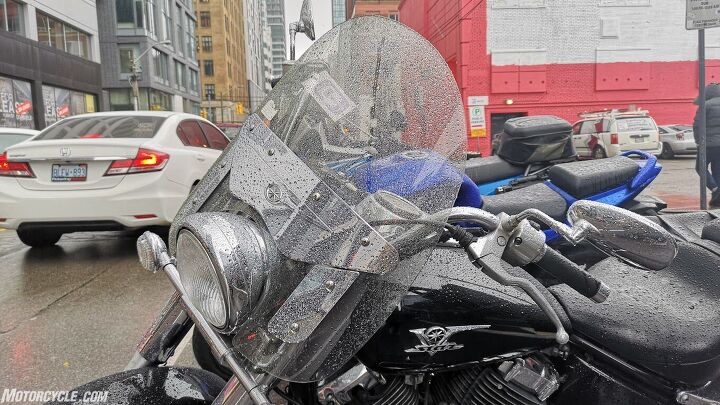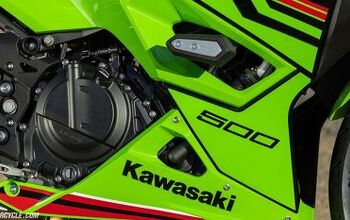Guide to Motorcycle Rain Gear

When weather’s a factor – especially rain and cold – your gear makes the ride.
Stifling heat in Death Valley. Biting cold in Michigan winters. Hail and snow in the Mojave. Flattening winds in the Texas panhandle. You name it, we’ve ridden through it. Oh yes, include in the list a drenching cyclone in New Zealand. In that one, veritable buckets of rain per minute descended on our group like heaven’s own turbocharged water wastegate, driving us into the nearest general store, looking for new gear to wear. (All we found were wool mittens.)
So, what have we learned? When weather’s an issue, good gear – no, make that the perfect gear – makes the ride. If you get caught in bad weather with the wrong outfit or no rain gear at all, every minute is a fresh slice of misery. But cozy in effective rain gear, you can practically laugh at the wet and cold. Here’s what works for us.
Motorcycle.com thanks Yamaha for sponsoring this new rider series.
One vs. Two Piece
In our experience, a one-piece rainsuit stands the best chance of keeping you dry from neck to wrists to ankles. This includes in the seat and waist area, which is a prime area for rainwater to pool, collect and creep inside, which guarantees supremely annoying and disappointing miles to follow. The only real downside here is that one-piece suits are physically a bit large and bulky, can be more trouble to put on and remove, and can represent a drying/storage space hassle – especially when you’re on the road. For instance, walking wet into a restaurant, or crammed into a tent or motel room, where are you going to hang a big, wet, one-piece rain suit to dry?
Two-piece suits are way friendlier in this regard, but they’ll ideally have zippered waists to keep water out at the midsection – and hopefully waterproof zippers. That aside, there’s no reason a two-piece rain suit can’t perform well alongside the one-piece variants. An extra advantage to two-piece rain suits is the ability to use the jacket only in variable weather, or even as a regular riding jacket if it’s the top half of a rally or touring outfit. This means that while traveling or touring, you can stow the lower half (i.e., the pants), donning them only when rain falls or you need a bit of extra thermal protection.
Try as many brands of both styles as you can, and then buy quality. Looking back at the decades, though, for convenience and versatility in moderate conditions, we’d go with two-piece. For absolute protection in terrible conditions, make it one-piece.
Materials
Thankfully, foul-weather materials have evolved since Edmund Hillary scaled Mt. Everest in 1953 and Ted Simon rode around the world in the 1970s for his book Jupiter’s Travels. In period, motorcyclists had leather, of course, and waxed cotton jackets and pants. Then Gore-Tex arrived in 1976, the scientifically engineered polymer that could stop water droplets but allow perspiration to escape. That was a game changer, and its inventive attributes are still present in motorcycle rain gear today.
On the affordable end of the rain-gear spectrum, nylon and polyester are go-to materials for manufacturers. They are flexible for comfort, but they do tend to absorb water. This is why the best of such rain suits have inside coatings to improve their waterproofing performance. A downside of nylon and polyester is their lack of breathability, meaning that such a rain suit (or jacket or pants) is like a one-trick pony: wear in the rain only. Otherwise, you may get sweaty – or even hot and sweaty.
Further up the cost ladder, other available rain-suit materials include (surprise!) a modernized waxed cotton, waterproof and breathable leather with an inner laminate to maximize wet-weather performance, and the aforementioned Gore-Tex style. As is often the case in technical gear, you get what you pay for. When shopping, check out the material descriptions carefully.
Lined vs. Unlined
Know that many “rain suits” may be essentially nylon or polyester shells, coated for superior performance. However, other than rain protection, they don’t usually offer insulation. For that, you need a rain suit that is also a touring suit or rally suit. Here the price jumps from maybe below $100 to likely $1,000 or more for a premium go-anywhere, world-traveler type riding suit.
Thermal Protection
Per the above: Unless you’re focusing on a touring, commuting, or rally suit that also happens to be rainproof (most likely are), a basic rain suit will not provide much in the way of warmth; its job, pure and simple, is to keep your clothes dry. In researching this article, we didn’t find any mention of thermal protection in basic rain suits, jackets, or pants. So, plan to stay warm another way!
Sealed Seams
Seam tape has been around practically forever. As the name implies, its purpose is to waterproof the seams where the rain suit is sewn and/or bonded together. You want this, and you want it to do its job. If the suit is good, its basic material is not going to leak – even if you’re sitting in a puddle of water on your touring bike halfway between Calgary and the Canadian Rockies. But if the seams aren’t taped, and sewed and/or bonded, correctly using the right materials, you’re going to be a wet puppy. Same goes for your armpits, chest, or wherever the pounding or immersion is worst. So, read the fine print on the suits you’re shopping; dig and keep digging until you find out all about the exciting world of seam tape!
Zippers
Pay attention here! Especially in cheaper rain gear, zippers may or may not be particularly waterproof. For instance, even among well-known brands, the zippers may be described only generally as “water resistant” or similar. We can tell you though, a truly waterproof zipper will probably have a noticeably “harder” or higher-friction action than a breezy typical zipper, due to its close tolerances and gasket-like interfaces. When you’re shopping, if the literature is of little use, closely investigate.
Warranty and Repairs
How much do you ride, and in what conditions? For some riders, rain gear may be just a cheap insurance policy, if you will, on a summer tour. For others, their rain gear is also their everyday riding suit, which costs as much as some used bikes. Before handing over the credit card, read the product warranty. You may find you’re outta luck with support on rips, tears, or poor performance with the cheapie gear. While on top-end products, you may be pleasantly surprised to find out the maker is behind you all the way and will repair or make right a wide range of problems. Sometimes, even if they’re your fault!
Become a Motorcycle.com insider. Get the latest motorcycle news first by subscribing to our newsletter here.

John L. Stein brings 30 years of both automotive and motorcycle experience, having written for AutoWeek, Car and Driver, Motor Trend, Sports Car International, Chevy Outdoors, Truck Trend, Cycle World, Motorcyclist, Adventure Travel, and Men’s Journal, just to name a few. His articles have been published in the US, England, Japan, Australia and France. His technical knowledge combined with his ability to understand and effectively communicate what a motorcycle is doing underneath him is an invaluable resource to the Motorcycle.com team.
More by John L. Stein
































Comments
Join the conversation
I have a 2-piece Rev'It that is Hi-Vis but that is when I used to use an Aerostich Roadcrafter II suit which is not waterproof even though it is Gore-Tex.
Since 2016, I now wear a KLIM Latitude suit (2-piece) and have never looked back. A suit that is totally waterproof in the heaviest of downpours.
Just finished a 600 mile ride around the Tip of the Mitt of Michigan on a fund raiser for Polio Eradication. Weather was nautical in nature with some areas receiving over 3 inches. We, three of us, soldiered on except when lightning strikes were close. Pooled water on roadways were a problem. Gear consisted of one fairly recent Aerostich two piece Darian, one older two piece Aeorstich and one other brand. Using glove covers from Aerostich and the two pieces Stiches worked great. Heated gear and Rainx are other factors that make rain riding more comfortable. After 13 hours and 40 minutes I was still high and dry except for my boots that are made for walking more that riding and had not been waterproofed in a few years. Other brand of gear, do not know name, wickered water inside. It did look real sharp. Fund raiser is still going on, please look at our site. https://raise.rotary.org/Justin-Andre/challenge1 A shortage of daylight hours and no shortage of deer on the move make Northern Michigan a little challenging this time of the year.